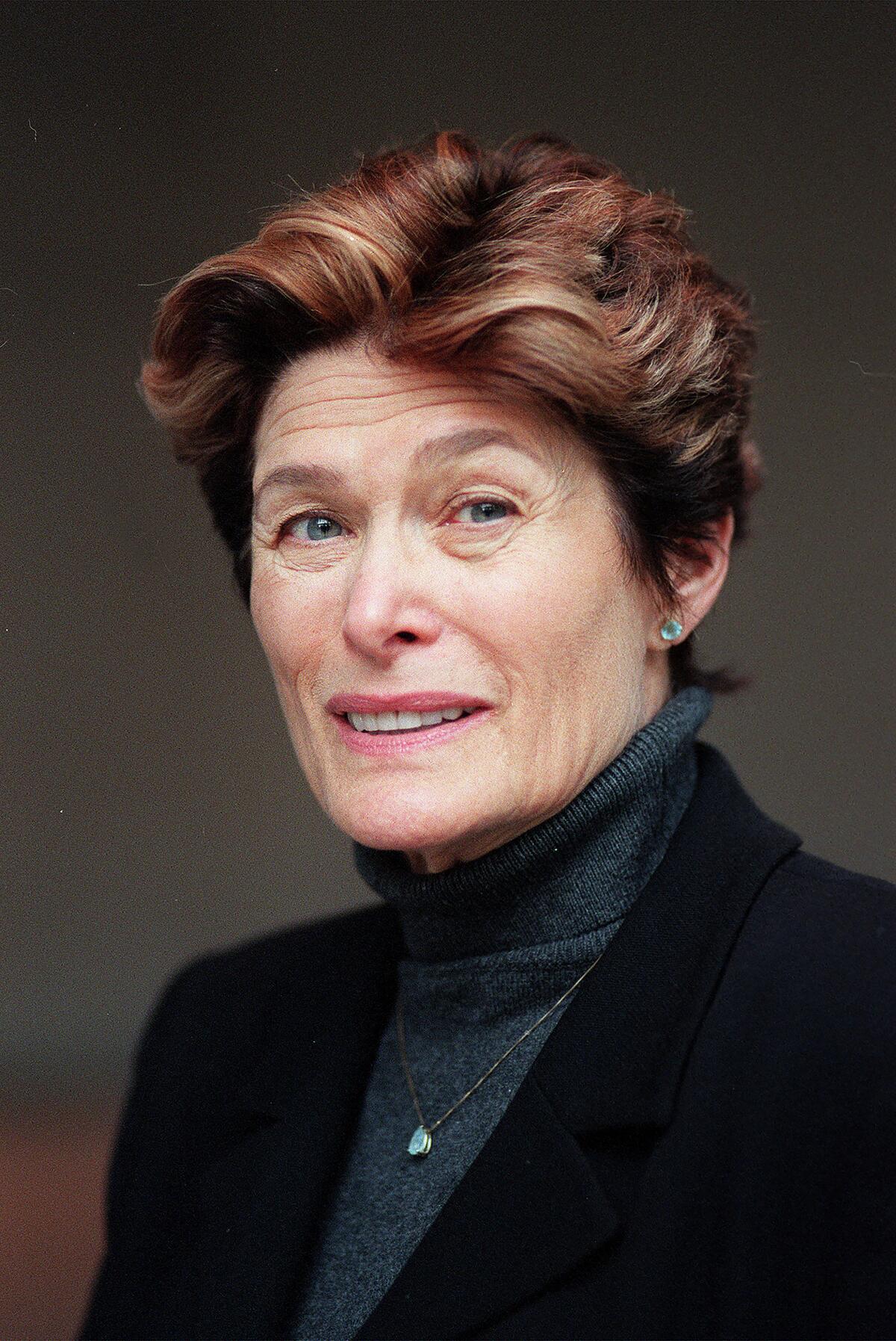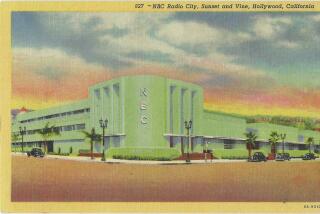Ruth Seymour, tastemaker who made KCRW a public radio powerhouse, dies at 88

Ruth Seymour, the longtime radio executive who built KCRW into a public media powerhouse in the late 20th century, transforming the sonic landscape of Los Angeles and beyond, died on Friday. She was 88.
Seymour’s death was confirmed by her daughter, Celia Hirschman.
For the record:
9:42 a.m. Dec. 24, 2023An earlier version of this article credited Seymour with coming up with title “Morning Becomes Eclectic.” The program was created by Isabel Holt before Seymour joined KCRW.
When Seymour arrived at KCRW-FM (89.9) in 1977, the station was housed in an elementary school adjacent to Santa Monica College, where staff could hear the hum of the nation’s oldest radio transmitter west of the Mississippi through the walls of the converted classrooms. The listenership at the time was just as modest, its numbers overshadowed by crosstown public radio peer KUSC-FM (91.5).
By the time Seymour retired as KCRW’s general manager in 2010 after more than 30 years at the helm, the transmitter had been upgraded, the offices had moved across the street to SMC, and KCRW had become a cultural and intellectual trendsetter not just for Angelenos but also for public radio listeners across America.
Seymour, a bohemian tastemaker with a keen eye for talent and often unrelenting standards, played a critical role in boosting the on-air careers of host and storyteller Ira Glass (“This American Life”), journalist Warren Olney (“Which Way, L.A.?” and “To the Point”), satirist Harry Shearer (“Le Show”), literary critic Michael Silverblatt (“Bookworm”) and film critic Elvis Mitchell (“The Treatment”). Her influence continued through KCRW creations like “Morning Becomes Eclectic” and “Left, Right & Center.”
“She was widely respected, she was disagreed with wildly, she was controversial,” said Susan Stamberg, a longtime NPR host and friend who hailed Seymour as visionary. “You always knew where she came from. She never hedged her words and she always made an impact, positive or negative.”
Seymour’s presence often was an exercise in contrasts. She was a New York intellectual who found a home in sunny Santa Monica; a female leader thriving in a media industry dominated by male executives; a colorful elbow-thrower in the staid academic world of public radio; a snob who was not above the occasional PR stunt; and a secular Jew who broadcast hours of Yiddish cultural programming on December’s typically Christmas-dominated airwaves.
KCRW manager succeeded by being true to herself
Seymour’s three-hour annual show celebrating Yiddishkeit — called “Philosophers, Fiddlers and Fools” — launched in 1978 with a combination of music, stories and Yiddish. It was quintessentially Seymour, quintessentially eccentric, and it landed.
“The program ended and ‘All Things Considered’ came on the air,” Seymour recalled in an essay years later. “The phones began to ring. And ring. And ring. They rang for hours. People waited until a line was free, just to say ‘thank you.’ Some were crying; others wanted to tell their own story; each call was emotional. We were a handful of individuals, in a little bungalow inside a deserted schoolyard, stunned and overwhelmed by the response to the program.”
Seymour was born Ruth Epstein — the first of three last names she’d adopt in life — on Feb. 17, 1935, at Sydenham Hospital in Harlem, N.Y. Seymour’s father, Jack Epstein, was a Polish-born furrier; her mother, Sylvia Gerlich, fled Poland after slapping a policeman in a dispute over some eggs, according to family lore.
The pair met at New York’s New School for Social Research and were active in the Workmen’s Circle, a cooperative association of Jewish workers, which led to lively debates about current events at the dinner table. “They were my link to the world of Yiddishkeit, a world that was being destroyed as I was growing up,” Seymour recalled later. It was a world she would later resurrect over the airwaves.
Seymour studied Hebrew and Yiddish at the City College of New York under famous linguist Max Weinreich. There, she met her future husband, prominent Beat poet Jack Hirschman, marrying him in 1954 and adopting his last name. (She rose to prominence under the name Ruth Hirschman and changed her last name to Seymour, in honor of a relative, later in life.)
It was a bohemian marriage that produced two children, Celia and David, and familial tours of duty at Dartmouth (Jack was a professor), UCLA and across Europe. Counterculture was in the air, as was a bit of cultural celebrity: The family was friends with Anais Nin, Allen Ginsberg and Leonard Cohen.
Seymour, starting a career in radio journalism, conducted interviews by tape, but one day, “I threw my tape recorder into the Aegean and went off to live on a Greek island,” she later told The Times. “I gave up an interview with Jean-Paul Sartre when he won the Nobel Prize to go to Greece and be an existentialist.”
“[My] parents were a bit hedonistic and narcissistic and adventurous; the focus was not on the children,” Celia Hirschman said. “We were loved, deeply, but the focus was on their experiences. That’s a pretty unconventional life.” Observing the family, songwriter Cohen called them “four archipelagos,” Hirschman said.
The archipelagos drifted farther apart. Ruth and Jack divorced in 1973. By then, she had taken a job as a program director at the left-wing Los Angeles radio station KPFK-FM (90.7), producing programs on great artists. The station also aired tapes from the Symbionese Liberation Army, which had kidnapped Patricia Hearst.
Her business partner, general manager Will Lewis, said he created a program guide that “welcomed all communications from any group, and we pledged to keep the information confidential.”
“I felt obligated. Ruth didn’t like the idea right away,” said Lewis, who served time in jail for contempt of court for refusing to hand over the tapes to law enforcement.
After the pair were dumped by KPFK in some kind of intra-leftist purge, Seymour landed as general manager of KCRW in 1977 and brought along Lewis as a management consultant. It was a professional partnership that would last for 30-plus years.
With the ’60s and its cultural revolutions and radical campaigns fading in the rearview mirror, Seymour’s fateful twist at KCRW was to repackage leftist cultural sensibilities for a merely left-ish Santa Monica mainstream, plus a heavy dose of media savvy.
The transmitter got upgraded, and the potential audience got way bigger. On came the talent, whom Seymour spotted: comedian Shearer, storyteller Joe Frank, a generation of hipper disc jockeys. On came the eclectic and literary programming: drama and comedy, sometimes from Europe. On came the grants and the Hollywood-aided fundraisers.
Seymour flooded the airwaves with NPR programming, sometimes running the same program three times a day to edge out other NPR affiliates for listeners. Potential audiences turned into real audiences.
“What she has done is very clever,” public radio host Larry Josephson later told The Times. “She has taken the cultural and literary and public affairs content of KPFK and molded it to a more conservative audience. I think a large part of her audience are former New Yorkers. They moved out West to run the movie business.”
One of Seymour’s most remarkable qualities was her utter confidence in her own judgment. She quickly became one of NPR’s most high-profile, most respected, most polarizing affiliates. At NPR meetings, “Ruth will stand up and yell, ‘That stinks!’” host John McNally later told The Times. “Public radio people weren’t used to that.”
Public radio people also sometimes desperately needed her. In the 1980s, as NPR floundered financially, Seymour led fundraising campaigns, helping save “Weekend All Things Considered.” She personally led a special pledge drive to help fund expanded NPR coverage of the 1991 Persian Gulf War.
“She got on the air, she put on a camouflage uniform and put on tough-looking boots,” said Stamberg. “She said, ‘This is a war, we’re going to cover it, and the way we’re going to do it is with your money so we can send the very best reporters over there.’” She earned the nickname “National Public Ruth.”
Seymour’s supreme confidence drew admirers and created passionate critics, who were sometimes one and the same. “She was able to cultivate talent when she saw it, and she had high standards,” Lewis said. “She would fight with Larry Josephson over the content of his program, in a real shouting match.”
“It’s not a good idea to oppose her unless it’s really important,” Josephson later told The Times. “I think once she admitted she was wrong to me years after we had an argument. She has a tremendous will, and once she wills something, nothing gets in her way, including the facts. She’s kind of like an avenging angel from the Bronx who landed in Southern California.”
Some felt her firings and show cancellations could be ruthless, especially in the generally gentler environs of public radio.
“She was not an easy person to work for, to say the least,” said retired host Olney, whom Seymour hired in 1992 after the L.A. riots to strengthen KCRW’s local news offerings. “A lot of the decisions she made were, from an objective standpoint, probably the right decision, but [were done in ways] that were hurtful to people. And she didn’t have much patience for that kind of concern.”
Others found Seymour’s forcefulness inspirational.
“It’s really important knowing that there’s someone out there who’s going to pressure you to be excellent, and I have always been influenced by and in awe of a woman, a person who operated without caring what people thought of them,” said Jennifer Ferro, Seymour’s successor as head of KCRW. “She was going to make what she knew was the right decision, and I often look to that for inspiration when I make hard decisions.”
Seymour’s instincts and attention to detail are still felt to this day. In 1996, KCRW became the first public radio station outside Chicago to broadcast Glass’ “This American Life.” Except it wasn’t originally called “This American Life,” it was called “Your Radio Playhouse.”
“She was very insistent that it was a terrible title,” Glass later said. “If not for Ruth, we still might have the other title.”
Seymour’s most enduring effect on music was her years overseeing KCRW’s “Morning Becomes Eclectic,” an inspiration to producers and indie music fans all over. Its title is a riff on the title of the 1931 play “Mourning Becomes Electra” by Eugene O’Neill.
Of Seymour’s era at KCRW, “the single most enduring thing is ‘Morning Becomes Eclectic,” Ferro said. “That’s a legacy that continues and I love that. ... She had this intellectual rigor, intellectual commitment that was pretty unparalleled for L.A.”
At the end of Seymour’s career in the late 2000s, however, the economy was in turmoil, legacy media was starting its fateful shift toward less gatekeepery digital media and KCRW’s audience numbers had started to flag a bit.
“Suddenly, one day she came in and said, ‘I’m leaving,’” Lewis recalled. And like that, a whole era in radio had come to an end, unto herself.
“Ruth was one of the great figures in public broadcasting,” Lewis said.
Seymour is survived by her daughter, Celia. Her former husband, Hirschman, died of COVID-19 in 2021. Her son, David, died of lymphoma in 1982 at age 25.
According to biographical material prepared by Celia, Seymour, profoundly affected by the experience, had spent each anniversary of her son’s death alone, “walking on the beach and then spending time going through photos and cracking open the door to a grief that she carried constantly within her, but managed to keep hidden from the rest of the world.”
In a 1987 interview with The Times, Seymour recalled what she had learned from giving up on interviewing Sartre, moving to a Greek island and communing with the meaning of it all, if there even was any.
“Well, you know it’s not the end that is important,” Seymour said. “It never is. It’s always the journey itself. It’s not what you find. It’s the search. A lot of people lost their way, but those of us who survived, I think, are better off for it.”
More to Read
The biggest entertainment stories
Get our big stories about Hollywood, film, television, music, arts, culture and more right in your inbox as soon as they publish.
You may occasionally receive promotional content from the Los Angeles Times.











